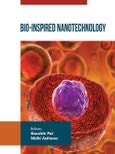Bio-Inspired Nanotechnology focuses on the use of bio-inspired and biomimetic methods for the fabrication and activation of nanomaterials. It summarizes recent developments in biocompatible and biodegradable materials, including their properties, fabrication methods, synthesis protocols, and applications.
This includes studies concerning the binding of the biomolecules to the surface of inorganic structures, structure/function relationships of the final materials, and unique applications of such biomimetic materials in harvesting/storage, biomedical diagnostics, and materials assembly. The book chapters also cover a range of available bio-based nanomaterials, including chitin, starch and nanocellulose.
It serves as a detailed reference for learners and anyone interested in sustainable nanoscale materials, including materials scientists, biomedical engineers, environmental scientists, food and agriculture manufacturers and scientists.
Table of Contents
Chapter 1 Design and Characterization of Smart Supramolecular Nanomaterials and Their Biohybrids
- Introduction
- Supramolecular Nanoparticles (SNPs)
- Hybrid Supramolecular Nanostructures
- Stacking of Snps
- Design and Synthesis of Supramolecular Biohybrid Materials
- Design of Snps As Sensors and Drug Delivery System
- Bioconjugation of Snp System Over Metallic Surfaces
- Nanoaggregation As Signal Transducers
- Design of Supramolecular Polymeric Nanoparticles
- Advantages of Supramolecular Biohybrid Materials
- Modularity
- Dynamic Reciprocity
- Biomimicry
- Characterization Techniques Used in Supramolecular Chemistry 7 Small and Wide Angle X-Ray Scattering (Saxs and Waxs)
- Dynamic and Static Light Scattering (Dls and Sls)
- Calorimetry
- Fourier Transform Spectroscopy Ft-Ir
- Ultra Violet-Visible Light Absorption Spectroscopy
- Fluorescence Spectroscopy
- Nuclear Magnetic Resonance Spectroscopy
- Scanning Electron Microscopy
- Transmission Electron Microscopy
- Atomic Force Microscopy
- Applications of Supramolecular Biohybrid Nanomaterials
- Drug Delivery
- Regenerative Medicine
- Immuno Engineering
- Conclusion and Future Aspects
- Abbreviations
- Consent For Publication
- Conflict of Interest
- Acknowledgements
- References
Chapter 2 Biocompatible Composites and Applications
- Introduction
- Materials and Methods
- Materials
- Modification of Zsm-5 Zeolite
- Preparation of Zeolite/Cnf Nanocomposite Films
- Characterization of Nanocomposite Films
- Batch Dye Adsorption Studies
- Results and Discussion
- Nanocomposite Characterization
- FTIR Analysis
- Dye Adsorption Analysis: Adsorption Equilibrium and Kinetic
- Adsorption Kinetics
- Adsorption Mechanism
- Conclusion
- Consent For Publication
- Conflict of Interest
- Acknowledgement
- References
Chapter 3 Polymer Nanocomposite Technologies Designed For Biomedical Applications
- Introduction
- Polymer Nanocomposites
- Biomedical Applications Polymer Nanocomposites
- Bio-Based Polymer Nanocomposites
- Carbon-Based Polymer Nanocomposites
- MOF/Polymer Nanocomposites
- Smart Polymers
- Conclusion and Future Perspectives
- References
Chapter 4 Novel Polymer Nanocomposites: Synthesis, Designing and Cost-Effective Biomedical Applications
- Introduction
- Cellulose Based Polymers
- Chitosan-Based Polymer
- Other Biopolymers
- Metal and Metal Oxide Nanoparticles
- Carbon-Based Nanostructures
- Polymer-Based Nanoparticles
- Polymer Nanocomposites
- Conclusion and Future Outlook
- Consent For Publication
- Conflict of Interest
- Acknowledgement
- References
Chapter 5 An Emerging Avenue of Nanomaterials Manufacturing and Prospectives
- Introduction
- Nanomaterials and Nanotechnology
- Methods of Nanoparticle Synthesis
- Physical Method
- Chemical Method
- Biogenic Synthesis: the Green Alternative
- Nanomaterials For Emerging Technologies
- Nanomaterials For Food Industry
- Nanomaterials in Food Processing
- Nanomaterials in Food Packaging
- Nanomaterials For Agricultural Science
- Nanomaterials in Medicine
- Nanomaterials for Power Sector
- In Harvesting Energy
- In Energy Storage and Distribution
- Nanotoxicology and Related Risk Management
- Conclusion
- Consent For Publication
- Conflict of Interest
- Acknowledgements
- References
Chapter 6 Current Research Trends of Graphene Nanotechnology
- Introduction
- Status of Graphene in Nanotechnology
- Synthesis and Properties of Materials Based on Graphene
- Graphene Synthesis
- Properties of Graphene
- Electric Properties
- Thermal Properties
- Mechanical Strength
- Chemical Properties
- Optical Properties
- Electrical Properties
- Functionalization of Graphene
- Application of Graphene
- Composite Materials
- Conductive Polymers
- Electrochemical Sensors
- Devices for Power Storage or Transformation
- Supercapacitors
- Water Purification
- Conclusion and Future Opportunities
- Consent For Publication
- Conflict of Interest
- Acknowledgement
- References
Chapter 7 Nanomedicine Technology Trends in Pharmacology
- Introduction
- Nanomaterials and Nanodevices
- Nanotechnology - History
- Classification of Nanomaterials
- Liposomes
- Dendrimers
- Metallic Nanoparticles
- Carbon Nanotubes
Author
- Kaushik Pal
- Nidhi Asthana








